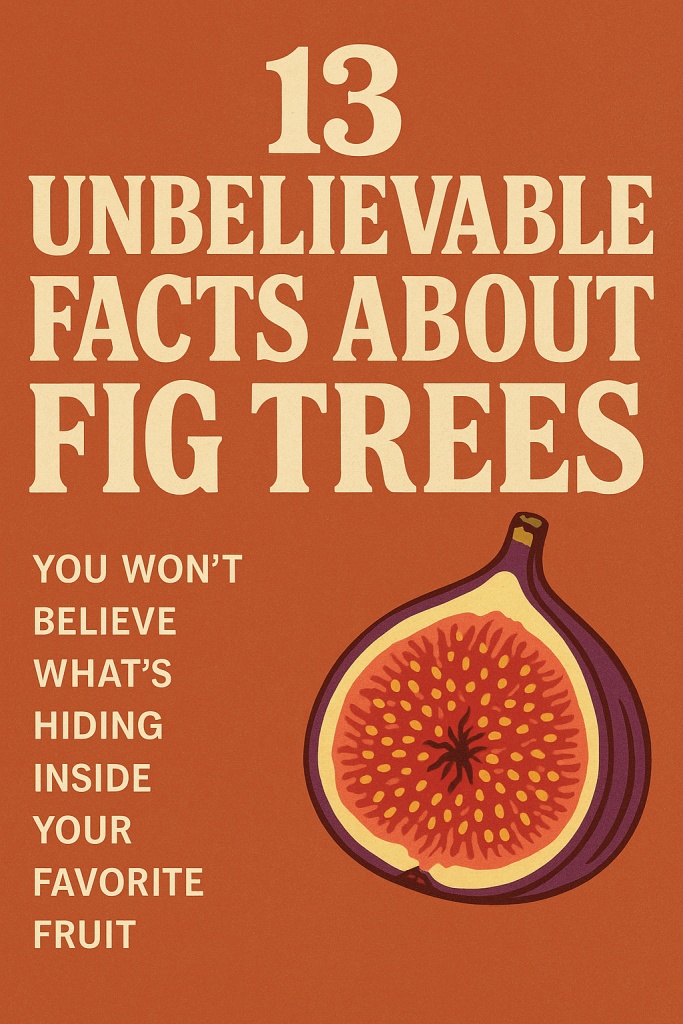Learn about Figs
13 Unbelievable Facts About Fig Trees
You won’t believe what’s hiding inside your favorite fruit.
You might think you know figs—those sweet, squishy bites of heaven tucked inside your favorite energy bar or drizzled over goat cheese. But fig trees? Whole other story. These ancient, twisty, moody plants have secrets. Weird ones. Wonderful ones. Some of them are borderline shocking.
Let’s just say, once you learn what’s really going on inside a fig (literally), you’ll never look at them the same way again.
Ready? Here are 13 fig facts that’ll blow your gardening gloves off.
1. There’s a dead wasp inside some figs (and it’s not gross—promise)
Let’s get this out of the way: yes, some edible figs technically contain a digested wasp. But don’t freak out. The fig tree and a tiny wasp species have this ancient pact—figs offer a home for the wasp’s babies, and in return, the wasp pollinates the fig. The fig actually digests the wasp using an enzyme called ficin, so by the time you’re eating it, it’s just… well, plant mush. Wild, huh?
2. Fig trees aren’t technically fruit trees
They’re actually inverted flowers. What looks like a fruit is a syconium—a hollow vessel with tiny flowers on the inside. Yeah, figs are basically introverted flowers hiding their beauty inside. If that’s not poetic, I don’t know what is.
3. They’ve been cultivated longer than wheat
Archaeologists found evidence of domesticated figs in the Jordan Valley dating back to 9,400 BCE. That’s older than the first known grain crops. Figs might’ve been the original “this changes everything” food.
4. Figs can grow from sticks. Literal sticks.
Cut a branch, stick it in soil, water it, and wait. That’s it. Fig propagation is like fig magic. This is how folks trade rare varieties—swapping hardwood cuttings online or at farmer’s markets like fig-crazy Pokémon trainers.
5. There are over 800 types of fig trees
And some of them? Almost too beautiful to be real. Think deep purple skin with strawberry-red flesh. Others are green and candy-sweet, like the Adriatic or Kadota. Some are so rare, collectors hoard them like treasure. Black Madeira, anyone?
6. You can grow them indoors… with some patience
Figs can be indoor plants—if you’ve got good light and a sturdy container. Just don’t expect massive fruit right away. But if you live in a cold climate and want your fig fix year-round, a sunny window and a grow light might do the trick.
7. Their roots are wild and stubborn
Fig tree roots will find water. Got a pipe leak underground? A fig tree might sniff it out like a truffle pig. That’s why you shouldn’t plant them right next to your house unless you’ve got a root barrier or a serious sense of adventure.
8. They’re weirdly drought-tolerant and still thrive
Figs don’t complain. They can go weeks without water once established, and still give you luscious fruit. In places like California or parts of the Mediterranean, they practically grow themselves. Think of them like that low-maintenance friend who never needs anything but always brings snacks.
9. Fig leaves are surprisingly useful (and delicious)
You can cook with them! Fig leaves give off a subtle coconut-vanilla scent when used to wrap fish or infuse milk. And if you’ve ever seen those lush, oversized fig leaves, you know they’re also excellent for “tropical jungle vibes” in your garden.
10. The latex from fig leaves can irritate your skin
Not to be dramatic, but fig trees have a dark side. The white sap (latex) from leaves and branches can cause skin irritation—especially under sunlight. It’s called phytophotodermatitis. Fancy word, but basically: wear gloves when pruning.
11. Some figs don’t need pollination at all
Certain varieties, called “parthenocarpic,” produce fruit without pollination. The most famous? The Black Mission fig. No wasp needed. This makes them perfect for places where fig wasps can’t survive—like most of North America.
12. Fig trees were one of the first cultivated in pots in ancient Rome
The Romans were obsessed with figs. They grew them in amphora-shaped clay containers and moved them between sunny courtyards. Imagine Julius Caesar walking past a potted fig tree, nibbling dried fruit, plotting world domination.
13. Figs are deeply spiritual—literally sacred in many cultures
In Buddhism, Siddhartha Gautama attained enlightenment under a fig tree (the Bodhi Tree). In Christianity, fig leaves famously made the first pair of pants. Even in Islam and Judaism, figs are considered fruits of paradise. They’re not just sweet—they’re symbolically rich.
Final Thought: So much more than just a fruit
Figs are living time capsules. They’ve fed empires, hidden wasps, dazzled collectors, and inspired poets. If you’re thinking of growing a fig tree, you’re not just planting something to eat—you’re stepping into a 10,000-year-old tradition.
And who knows? Maybe one day, someone will marvel at your tree and say, “Wait… there’s a wasp in there?”

